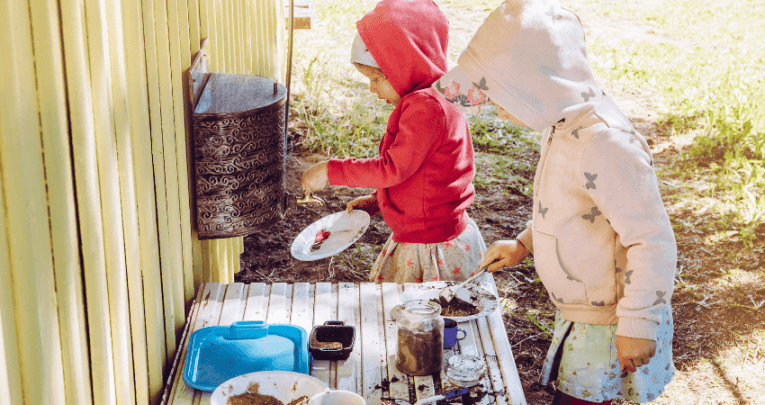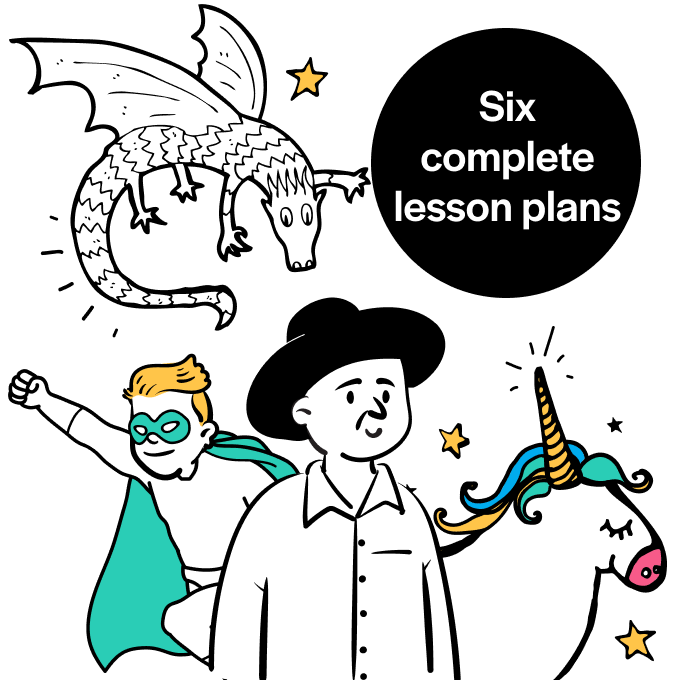Outdoor learning – Ideas for taking your class outside

Looking to invigorate your classroom with fresh air and hands-on learning? Explore these engaging outdoor learning ideas designed to captivate and educate your students…

- by Teachwire
- Classroom expertise and free resources for teachers

Keen to ditch the iPads and introduce your pupils to the joys of nature-based classes, but not sure where to start? Try the below outdoor learning ideas…
If you don’t have suitable school grounds, think about looking for local walk-to spaces such as your local park, community centre garden, graveyard, farm or friendly residents’ gardens.
Make sure you have landowner permission and have conducted a risk benefit assessment. Also consider whose insurance the outing falls under and whether you’re following your school’s off-site policy.
Outdoor learning ideas
Use natural materials
Using natural materials is a great way to reduce plastic, and encourage the health benefits that come from being outside in nature, including the healthy bacteria the lovely mud brings along with it.
There are lots of sensory benefits from touching the many different textures in nature, too – like sticks, rocks, leaves, and of course mud.
This can better support neurodiverse children accessing the curriculum, as well as those pupils who lack concentration while indoors.
Furthermore, using what’s out there is free! Nothing more to buy!
And if that was not enough to convince you to use more natural resources to teach, this might be: it can all be left outside. There’s nothing to prep or put away, making outdoor learning easily manageable.
Make an outdoor cupboard
If you do have outdoor resources that need to be stored somewhere, get creative and re-think the way you can keep your items safe (and tidy!).
Try making an ‘outdoor cupboard’ using upcycled containers. Use barrels, steel dustbins, or even old tyres, and fill them with natural items you will use to teach.
You can alter the materials depending on the season. So in autumn you might use conkers, acorns, various shades of fallen leaves, and sticks. (Bamboo sticks are especially useful because you can get packs of them that are equal in length and nice and straight).
Just as you may have an inside cupboard of supplies, you’ve now got somewhere to organise your outdoor classes.
Ban indoor items
To begin with, this one can be difficult. You may be used to your indoor apparatus such as a whiteboard or an iPad. However, for you to achieve lessons that really reap the benefits of being outside, you need to ditch them.
I have been there and got the t-shirt. By taking resources designed to be used inside, outside, you’ll open them up to damage and make life a lot harder for yourself. This makes you more reluctant to go outside again.
Furthermore, outdoor learning is supposed to provide pupils with experiences they can’t get inside. So keep the kids moving, embrace nature, and leave your digital tools behind.
Start with science
There are plenty of outdoor learning opportunities in both the EYFS and National Curriculum for outdoor learning. However, if you’re new to this it’s useful to start with science.
Many topics within this subject provide opportunities to take the children outside and get hands-on with their learning.
This is vital for the children who are practical and visual learners. It also helps those who like to move and explore.
Topics such as habitats, animals including humans, plants, and materials can all be explored outside, and pupils might even gain greater depth than being taught inside only.
Not all lessons have to be 100% outside
You do not have to take full lessons outside. There are no rules!
Try a combined approach and maybe keep intros inside with main activities outside.
When I train whole schools, I always advise KS2 to work this way, as children can sit and focus at their desks to hear what they’re going to be doing, but then have the chance to develop a greater depth of understanding by being outside where their senses are alive and learning experiences become memories.
In particular, repeated learning like times tables and number bonds can be explored in interesting ways outside, such as allowing pupils to create their own counting ladders from sticks, for example.
Go out in all weather
In all the years I have been a teacher, I’ve only had to abandon an outside lesson due to weather once.
It was a dangerously windy day, and so for safety reasons we couldn’t complete our activities, but very rarely does the weather get bad enough for long periods of time.
As long as the children are dressed appropriately, you can do this! Plus if you’re using only natural or upcycled resources it will not matter if it has rained, as nothing will ruin. Win-win!
Thanks to Sarah Seaman for these ideas. Sarah is CEO of The Muddy Puddle Teacher Ltd, and author of The Playful Way to Create an Outdoor Early Years Curriculum.
Read outdoors
Solitary reading outside offers special resonance, perhaps because our senses are more stimulated under a tree than next to a TV.
Read books that inspire students to explore nature, or ones specific to natural history – especially the natural history of their own backyard, city, and bioregion.
Make a root viewer
While we know that roots help plants absorb water and nutrients from the soil, they may be more complex than you think.
Plant roots use their hairs to feel around the soil. Recent research from the John Innes Centre showed just how: the hairs absorb nutrients by releasing a unique protein at their tips.
When the hairs hit rocks or other obstacles, they stop taking up nutrients, which in turn signals the root to find another path and start creating protein again.
Fill clear cups or bottles about four-fifths full with soil. Plant a seed or two in each cup, close to the edge. Place near a sun source.
Water, and observe as roots form and plants sprout. If you get really carried away with this project, you could be like Joe Atherton, who grows his world record–setting carrots in 21 foot-long plastic tubes.
Study bird behaviour
This activity is suggested by nature educator Herb Broda. ‘Many common birds such as jays, sparrows and starlings relish table scraps.
‘To test bird feed colour preference, add natural food colouring (eg beetroot juice, carrot juice, blueberry juice etc) to cooked macaroni and offer birds their choice of blue, orange, pink or uncoloured food.
‘Encourage students to generate predictions about how birds will react to the coloured food.’
Experience shades of green
Ask your students to collect small samples of differing shades of green that they find in the school grounds. Task them with finding five to 15 different colours then give each child a cardboard strip.
Trending
‘I slice up old manila file folders into two-inch-wide strips’, says Herb Broda, ‘then place a piece of masking tape, sticky side up, along the entire length.
‘Tell your students to look carefully at the collected samples and arrange them on the cardboard strip from lightest to darkest.
‘It works especially well if you limit the search area to a small space’, Herb advises. ‘Emphasise that although it’s OK to collect in school today, we shouldn’t sample anywhere else unless we have special permission.’
Hold a scavenger hunt
Scavenger hunts need no preparation or materials. They can re-energise flagging attention and be related to concepts being taught in school.
For example, ask the children to use their senses to find a soft object, something that makes a sound, smells good, is sticky or prickly.
Alternatively, gather an item for each letter of the alphabet, find geometric shapes in nature (eg circles, squares, triangles), or look for a bird, squirrel or insect home (be sure to stress that homes are not to be disturbed).
Other possibilities include finding ten examples of weathering or camouflage, something funny, sad, tired, old or young.
Seek out things that will not be here next year, next month, tomorrow. The Woodland Trust has comprehensive scavenger hunt downloads on its website, as does the RSPB.
Start a wonder bowl
Kids, particularly the younger ones, like to fill their pockets with natural wonders – acorns, rocks, mushrooms. ‘Wonder bowls’ are useful in classrooms, particularly in the early years.
In addition to facilitating the child’s desire to hunt and gather, they are a good way to collect items for show-and-tell and further study. To polish prized stones, use an inexpensive rock tumbler.
Play poohsticks
Herb Broda suggests an activity that comes directly from The House at Pooh Corner by AA Milne. The perfect setting is a small bridge over a slow-flowing stream, although the activity could be done from the riverbank if there is no bridge nearby.
The activity is simple: two or more players drop their sticks at the same time from the upstream side of the bridge.
The challenge is to see whose stick first appears on the other side. It’s amazing how a simple challenge like this can engage children (and adults) for quite a long time.
‘Of course you can ‘schoolify’ the activity by talking about rate of flow or stick trajectory’, says Herb. ‘But this really is an activity to do just for fun – to share a moment of exuberance with a group of children.’
Thanks to Richard Louv for these outdoor learning ideas. Richard is the author of seven books, including Vitamin N: The Essential Guide to a Nature-Rich Life (£12.99, Atlantic Books). For more information, visit richardlouv.com.
5 things you can’t teach in a classroom

1 | Tackling risk aversion
Today’s teenagers have grown up in a more protective environment than any other generation in history as parents try to safeguard their offspring from both physical and emotional risk.
When a situation arises, many won’t have had the experience of dealing with a hazardous scenario and so could freeze or make the wrong choice.
Forest schools activities like fire building and using axes encourage learners to take risks in a safe environment.
Rather than avoiding danger, teenagers can be taught how to assess whether a particular risk is worth taking, or should be avoided.
2 | Ecotherapy
As the social remit of education expands to tackle depression, stress and anxiety reduction, many PSE classes engage in innovative methods to aid the mental health of their senior pupils, such as yoga, for example.
Taking a class to a local park in the weeks leading up to exam season might not be a new idea – after all, the Victorians built asylums surrounded by greenery – but could actually make a long term difference.
Modern research confirms that levels of the stress hormone cortisol are lower when we are in nature, even for a short time.
The purpose doesn’t matter – whether it’s bird spotting, collecting twigs for an art project or reading Ted Hughes poems under the canopy of trees, time spent surrounded by nature can have a positive mental impact.
Furthermore, it’s far easier, and cheaper to replicate, than booking a massage or a course of aromatherapy.
3 | Health by stealth
Schools are often blamed for rising obesity levels in teenagers despite pupils’ myriad methods for getting out of PE lessons. In a forest school session, however, it is much harder to escape activity.
A session generally involves a couple of hours of constant movement, carrying heavy drums of water, sawing and collecting wood, and can only be accessed on foot.
The pupils must walk if they don’t want to be alone all night in the forest.
4 | Deep reflection
Some elements of a successful forest school lesson can’t be quantified – but you can really feel when something special has occurred, altering the group dynamic and giving individuals pause for thought.
A class sit on logs around a warm, crackling fire they have built, eating toast and drinking hot chocolate they’ve made themselves.
The joking, pushing and teasing stops, and a pleasant lull hangs over them as they stare into the flames.
Conversations begin, about dreams and aspirations. The creation of these types of valuable experiences simply cannot occur in the classroom (for a start, the health and safety officer would never allow the fire…)
5 | How to sleep
Research shows one of the biggest barriers to learning is a teenagers’ sleep deficit, but what can teachers do when pupils are regularly being messaged awake at 2am?
Exposing a class to natural light regularly through a forest school session helps regulate melatonin, the hormone which controls sleep.
And, as students come to realise how well rested and focused they feel the morning after they have been out in nature, they might even choose to get outside more often in their own time, too.
Gordon Cairns is an English and forest school teacher, who works in a unit for secondary pupils on the Autism Spectrum Disorder.










